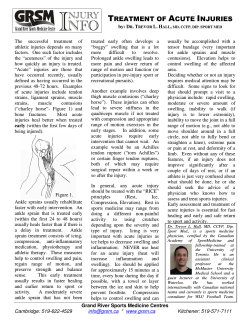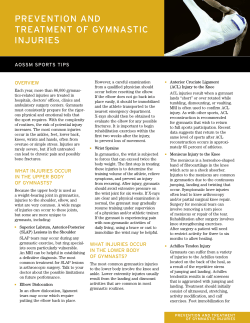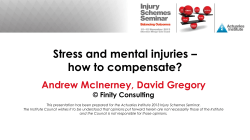
COVER SHEET
COVER SHEET Calder, James D F and Saxby, Terry S and Whitehouse, Sarah L (2004) Results of isolated Lisfranc injuries and the effect of compensation claims. Journal of Bone and Joint Surgery [British] 86(4):pp. 527-30. Accessed from http://eprints.qut.edu.au Copyright 2004 British Editorial Society of Bone and Joint Surgery Author copy: Calder JDF, Saxby TS, Whitehouse SL: Results of isolated Lisfranc injuries and the effect of compensation claims:- J Bone Joint Surg [Br] 2004;86(4):527-30 Results of isolated Lisfranc injuries and the effect of compensation claims. James D F Calder MD FRCS(Orth), Fellow* Sarah L Whitehouse PhD, Research Fellow† Terence S Saxby FRACS(Orth), Consultant Orthopaedic Surgeon* * Brisbane Foot and Ankle Centre, Arnold Janssen Centre, Holy Spirit Hospital, 259 Wickham Terrace, Brisbane 4000, Australia. †Orthopaedic Research Unit, Queensland University of Technology, Prince Charles Hospital, Rode Road, Chermside, Brisbane 4032, Australia. Address for correspondence: Dr T S Saxby FRACS, Brisbane Foot and Ankle Centre, Level Nine, Arnold Janssen Centre, 259, Wickham Terrace, Brisbane, QLD 4000. Australia. Tel : +61 (0)7 3834 6640 Fax : +61 (0)7 3834 6641 Email : forefoot@bigpond.co.au 1 ABSTRACT The results of treatment of Lisfranc injuries are often unsatisfactory. This retrospective study investigated 46 patients with isolated Lisfranc injuries a minimum of 2 years following surgery. 13 patients had a poor outcome and had to change employment or were totally unable to find work purely as a result of this injury. The presence of a compensation claim (p=0.02) and a delay in diagnosis of more than 6 months were associated with a poor outcome (p=0.01). There was no association between poor functional outcome and age, gender, mechanism of injury or previous occupation. This study may have medico-legal implications on reporting prognosis for such injuries and highlights the importance of prompt diagnosis and treatment for such injuries. INTRODUCTION Injuries to the tarsometatarsal (Lisfranc) joint carry a high risk of chronic secondary disability. The outcome for displaced injuries is improved following anatomical open reduction and internal fixation (ORIF) but up to 20% may be misdiagnosed or overlooked altogether.1-4 Several studies report a high incidence of unsatisfactory results following treatment.1,2,5,6 Most reports however include patients with associated injuries that may influence the outcome – of 72 patients reported by Myerson et al, 81% were polytrauma patients and 32% had concomitant ipsilateral foot and ankle fractures.2 Therefore the true results of isolated Lisfranc injuries are difficult to interpret. Workers compensation has been shown to influence the results of treatment for other orthopaedic injuries.7 Although no significant correlation has been demonstrated between the clinical outcome and age, gender or injury pattern/classification for Lisfranc injuries, no reports specifically examine the influence of workers compensation on the ability of individuals to return to work.2 This may have implications on medico-legal reporting for prognosis of such injuries and back to work schemes employed by companies. The aim of this study was to investigate the long-term outcome of isolated, displaced Lisfranc injuries requiring operative intervention and identify whether results of treatment are influenced by workers compensation. PATIENTS AND METHODS For this retrospective study the clinical notes were reviewed of all patients who underwent operative intervention for Lisfranc injuries between January 1995 and January 2000. The senior author performed all operations over the five-year period. Patients with concomitant injuries were excluded from further investigation so that the outcome of isolated Lisfranc injuries could be assessed. The presence of a compensation claim arising as a direct result of the injury was recorded and, where appropriate, workers compensation (Workcover) records were examined to identify the financial implications of such injuries. 2 All patients were contacted to record their employment status. Functional outcome of surgery was recorded on an ordinal scale: 1 - returned to normal employment, 2 returned to previous employment but with minor modifications, 3 - had to change employment and 4 - unable to perform any useful work purely as a result of the injury. The outcome was considered to be good if the functional result was recorded as 1 or 2 and poor if the result was 3 or 4. Initially, tests of association were performed using chi-squared tests with Bonferroni’s correction for multiple testing being applied. Where small frequencies were encountered, condensing of data was necessary and Fishers exact test performed. The correlation of age with outcome was assessed using Kendall’s tau which is a nonparametric measure of association for ordinal variables (as outcome is ordinal). However, due to the condensing of data that this type of testing necessitates and hence the loss of information, it is possible that spurious results may ensue. As a result, ordinal regression analysis was then performed to identify which factors influenced the outcome. Ordinal regression is an extension of logistic regression which allows for an ordinal dependent variable rather than a dichotomous one.8 Due to the number of subjects in the sample, it is advisable to include a maximum of 5 explanatory variables in the regression model with the introduction of dummy variables for nominal variables. The results from the association tests were therefore used in order to identify which explanatory variables were most likely to be influential in the model. Further analysis was then performed on this subset of variables. Data was collated using Microsoft Excel, and statistical analysis performed using the SPSS statistical package. RESULTS Fifty four patients were identified from records. Eight patients could not be contacted and so were excluded from further analysis. There were therefore 46 patients studied. All characteristics and associated outcomes are presented in Table 1 along with pvalues obtained when each characteristic was tested for association with outcome (good/poor) using Fishers exact test. The critical value for significance at 5% using Bonferroni’s correction in this instance is p=0.01. Of the 46 patients studied, 24 had pursued medico-legal claims as a direct result of their injuries (16 Workcover and seven civil claims). This was significant at the 5% level when testing for association using Fishers exact test (p<0.01) as described in Table 1. The minimum duration of follow-up was 48 months after the date of final surgery (range 48-84 months). There were 33 men and 13 women with a mean age of 36.3 years (range 17-60). Age was not correlated with outcome (Kendall’s tau = 0.094). The cause of injury was a low energy twist in 25 patients. High-energy injuries included a crush injury in ten patients, a fall of greater than two metres in seven and a motor vehicle accident in four. Due to low expected frequencies, this factor was compared as high versus low energy injuries which yielded a significant result at the 5% level after correction for multiple testing (p=0.01). These characteristics are detailed in Table 1. 3 The time interval from injury to surgery in 25 patients was less than three months. Four patients were seen at three to six months and 17 patients were treated more than six months following injury. Treatment was by ORIF or fusion using 4.5mm cannulated screws. Those patients seen within three months of injury underwent ORIF followed by six weeks in cast and subsequent removal of metal at three to four months. When surgery was delayed longer than six months from injury all patients underwent fusion. Two of the four patients seen between three and six months from injury underwent fusion. Three patients in whom ORIF was initially performed required fusion because of secondary osteoarthritis. Two of these patients underwent ORIF within 1 month of injury and the third patient underwent ORIF at 3 months. Delay of operation was tested for association as delay of less than 3 months versus delay of greater than 3 months due to low expected frequencies (p=0.01), which was significant at the 5% level as shown in Table 1. Occupations at the time of injury included 16 manual workers (builders/labourers), 16 patients whose jobs included walking/long periods of standing (teachers/nurses) and 14 sedentary workers (office/desk-based). Again, due to low expected frequencies, these were condensed to manual versus walking, standing and sedentary jobs. There was no significant association between occupation and outcome as seen in Table 1 (p=0.248). Using the results from the above analyses to identify which variables are most likely to be influential in the model (with 46 cases, a maximum of 5 explanatory variables should be included in the regression model), ordinal regression was performed to identify factors which may be influential in the model. Dummy variables were created where the data type dictated. In order to keep the number of explanatory variables to 5, in the occupation category, fall and MVA were combined as these had the lowest frequencies. Subsequent testing indicated that this did not alter the final model. The results from this analysis are shown in Table 2. The only factors which significantly influenced outcome were the presence of a compensation claim (p=0.023) and delay in treatment of more than 6 months (p=0.010 for more than 6 months and p=0.062 for between 3 and 6 months). Supplementary analysis indicated that there was no significant difference between delay in operation of more than six months and delay of between 3 and 6 months (p=930). This is due to the fact that there are only 4 subjects in this group. Hence the significant factor is a delay in treatment of greater than 6 months. Also, changing the dummy reference for injury type did not significantly change the model (ie all types of injury are not significant). 4 DISCUSSION Although pure ligamentous injuries carry a poorer prognosis than fracturedislocations, it has previously been shown that classifications do not correlate with outcome.1,2,6 We selected only displaced injuries requiring operation and did not attempt to classify them. Symptoms following Lisfranc joint injuries may improve for an average of 1.3 years5 and therefore we also ensured a minimum follow-up of 2 years before assessing patients’ ability to return to work. This study has demonstrated that those patients who are pursuing compensation claims following surgery for displaced Lisfranc injuries have a poor prognosis, independent of any other factors. This should be borne in mind when predicting outcome following operation for Lisfranc fracture/dislocations in medico-legal reporting. This finding also has important implications for Workcover or companies responsible for schemes aimed at returning such patients to full employment as the average Workcover payment was over $50,000 (approximately ₤20,000). Myerson et al recommend open reduction for more than 2mm displacement or a tarsometatarsal angle greater than 15°. 2 Lisfranc injuries are notoriously difficult to diagnose and up to 20% are missed at initial presentation thus delaying treatment.4 Delayed diagnosis is a particular problem in the polytrauma patient where the injury may be overlooked altogether.2 Weight-bearing views when the patient is more comfortable or MR/CT scanning have all been shown to improve diagnosis.9-13 We have demonstrated that a delay in diagnosis may have a detrimental effect upon the eventual clinical outcome and this highlights the importance of maintaining a high index of suspicion when the mechanism of injury raises the possibility of a Lisfranc fracture/dislocation. This series of 46 patients has a long follow-up of a rare injury. We have demonstrated that delay in treatment or a concomitant compensation claim are both associated with a poor prognosis. Age, gender, mechanism of injury or occupation prior to injury do not appear to effect outcome. The authors wish to thank Dr Rory Waggon, Senior Medical Officer and Mrs Karen Innes-Walker, Senior Medical Administrator for their help in collating data from Workcover Queensland records. 5 REFERENCES 1. Kuo RS, Telwani NC, DiGiovanni CW, Holt SK, Benirschke SK, Hansen ST, Sangeorzan BJ. Outcome after open reduction and internal fixation of Lisfranc joint injuries. J Bone Joint Surg [Am] 2000; 82:1609-1618. 2. Myerson MS, Fisher RT, Burgess AR, Kenzora JE. Fracture dislocations of the tarsometatarsal joints: end results correlated with pathology and treatment. Foot Ankle Int 1986; 6:225-42. 3. Sangeorzan BJ, Veith R, Hansen S. Salvage of Lisfranc’s tarsometatarsal joint by arthrodesis. Foot Ankle Int 1990; 10:193-200. 4. Goosens M, De Stoop N. Lisfranc’s fracture-dislocations: etiology, radiology and results of treatment. Clin Orthop Rel Research 1983; 176:154-162. 5. Brunet JA, Wiley JJ. The late results of tarsometatarsal joint injuries. J Bone Joint Surg [Br] 1987; 69:437-440. 6. Richter M, Thermann H, Huefner T, Schmidt U, Kretteck C. Aetiology, treatment and outcome in Lisfranc joint dislocations and fracture dislocations. Foot Ankle Surg 2002; 8:21-32. 7. Tufescu T, Buckley R. Age, gender, work capability and worker’s compensation in patients with displaced intra-articular calcaneal fractures. J Orthop Trauma 2001; 15:275-279. 8. McCullagh, P. Regression model for ordinal data (with discussion). Journal of the Royal Statistical Society, Series B 1980; 42:109-127. 9. Leenen LP, van der Werken C. Fracture-dislocations of the tarsometatarsal joint, a combined anatomical and computed tomographic study. Injury 1992; 23:51-55. 10. Lu J, Ebrahim N, Skei M, Porshinsky B, Yeasting RA. Radiographic and computed tomographic evaluation of Lisfranc dislocations: a cadaver study. Foot Ankle Int 1997; 18:352-355. 11. Faciszewski T, Burks R, Manaster BJ. Subtle injuries if the Lisfranc joint. J Bone Joint Surg [Am] 1990; 72:1519-1522. 12. Myerson M. The diagnosis and treatment of injuries to the Lisfranc joint complex. Orthop Clinics North Am 1989; 20:655-664. 13. Potter HG, Deland JT, Gusmer PB, Carson E, Warren RF. Magnetic resonance imaging of the Lisfranc ligament of the foot. Foot Ankle Int 1998; 19:438-446. 6 Table 1. Frequencies of good and poor outcome (with percentages)) for each variable, p-values obtained with Fishers exact test and significance when corrected using Bonferroni. Explanatory variables Gender Compensation claim Delay in treatment Mechanism of injury Occupation Male Female Yes No ≤ 3 months delay 3 – 6 months > 6 months Twist (low energy) Crush (high energy) Fall (high energy) MVA (high energy Manual Standing/walking Sedentary Functional outcome Good (%) Poor (%) 21 (63.6%) 12 (36.4) 12 (92.3%) 1 (7.7%) 13 (54.2%) 11 (45.8%) 20 (90.1%) 2 (9.1%) 22 (88%) 3 (12%) 2 (66.7%) 2 (33.3%) 9 (52.9%) 8 (47.1%) 22 (88%) 3 (12%) 5 (50%) 5 (50%) 3 (42.9%) 4 (57.1%) 3 (75%) 1 (25%) 10 (62.5%) 6 (37.5%) 10 (62.5%) 6 (37.5%) 13 (92.9%) 1 (7.1%) p-value 0.051 0.006* 0.009* 0.009* 0.248 *significant at 5% Table 2. Ordinal regression analysis with outcome (1, 2, 3 or 4) as dependent variable and compensation claim, delay in treatment (dummy variable reference is delay less than 3 months) and mechanism of injury (dummy reference is twist) as independent variables. Variable Estimate Compensation claim -2.205 Standard Error 0.967 Delay 3 – 6 months Delay greater than 6 months Crush injury -2.130 -2.029 1.140 0.792 0.062 0.010* -4.365 to 0.106 -3.581 to -0.477 -0.691 0.983 0.482 -2.618 to 1.237 Fall or MVA injury -1.073 0.909 0.238 -2.855 to 0.709 *significant at 5% 7 p-value 0.023* 95% confidence interval -4.101 to -0.309
© Copyright 2025









